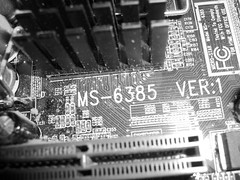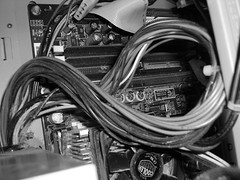 Accelerating change has never been adopted or accepted in classrooms around the world, even though most educators have come to accept change in their daily lives. Instead, as an organization, formal education has acted like a brake, forestalling significant change be it in the tools we use to teach and learn, or the theories we adopt in developing new teaching strategies.
Accelerating change has never been adopted or accepted in classrooms around the world, even though most educators have come to accept change in their daily lives. Instead, as an organization, formal education has acted like a brake, forestalling significant change be it in the tools we use to teach and learn, or the theories we adopt in developing new teaching strategies.In my second year of teaching, I was able to purchase my first home computer… an AT machine with a 386 microprocessor and the wonders of an EGA monitor (16 colours!). This machine was capable of doing many tasks, but it would be incapable of doing many of those now handled with ease by modern personal computers or mobile devices.
 The students entering classrooms during those early years of personal computing, were very different than those of the present day. Not only were their expectations of learning different, but their brains were wired for attention to the static reading and writing tasks presented to them. Handheld game machines, cell phones and other technologies, had yet to impact the lives of young people, let alone rewire their brains.
The students entering classrooms during those early years of personal computing, were very different than those of the present day. Not only were their expectations of learning different, but their brains were wired for attention to the static reading and writing tasks presented to them. Handheld game machines, cell phones and other technologies, had yet to impact the lives of young people, let alone rewire their brains.Today, the world is a very different place, and though the machines we use in our daily lives have changed significantly, the strategies we employ to teach present day students fail to address the reality that the world we share with our students is very different from the one that existed less than a generation ago.
Can you imagine a computer struggling to keep up with the processing requirements of today’s applications? How can we expect a teacher's pedagogical evolution to keep pace with the connected nature of today’s learner? I propose that the solution might be found in regularly scheduled upgrades of firmware (learning theory); software (pedagogy); and hardware (tools).
Upgraded Firmware: Learning Theory
 If learning is indeed evidenced by that forging of connections among neurons, people, and ideas, then classroom teachers need to do a better job of ensuring that their teaching strategies encourage and foster the creation of these connections. As new learning theories evolve, teachers need to be ready to learn and to adapt their teaching practices. Keeping current will ensure that the dust of past theories and related policies do not clog the machine.
If learning is indeed evidenced by that forging of connections among neurons, people, and ideas, then classroom teachers need to do a better job of ensuring that their teaching strategies encourage and foster the creation of these connections. As new learning theories evolve, teachers need to be ready to learn and to adapt their teaching practices. Keeping current will ensure that the dust of past theories and related policies do not clog the machine.Evolving Software: Pedagogy
In order for teaching & learning to evolve, educators must realize a sense of urgency in becoming lifelong learners. Though no one teacher can ever know it all, each of us can carve out a niche in which to focus our learning efforts. Whether our colleagues are down the hall, or a half a world away, given permission to network among peers, teachers have the responsibility to learn from and to teach one another. Though it will not be easy to upgrade, there is an ongoing need to rewrite the code of professional learning.
Modern Hardware: Tools
 Even though the business world finds ways to ensure that employees are working with the best available tools, students and teachers are required to work on lean budgets that prioritize work with pencils over work with modern tools. Still, educators will need to embrace evolving tools and mobile devices if they are to deliver learning experiences that are relevant. For the benefit of students and educators alike, tools of the present should be harnessed to forge connections well beyond the classroom walls.
Even though the business world finds ways to ensure that employees are working with the best available tools, students and teachers are required to work on lean budgets that prioritize work with pencils over work with modern tools. Still, educators will need to embrace evolving tools and mobile devices if they are to deliver learning experiences that are relevant. For the benefit of students and educators alike, tools of the present should be harnessed to forge connections well beyond the classroom walls.While the adoption of modern learning tools and connective technologies will require the support of administrators, and technology leaders, the classroom teacher will always be the most important peripheral device in the system.
Convincing current and future educators of the need for continual upgrades, will be no easy task. In my next post, I will propose a significant learning event that just might lead a generation of teacher-learners, to realize their potential as agents of change.
Photo Credit: All images are licensed for use by Jon A. Ross




0 comments:
Post a Comment